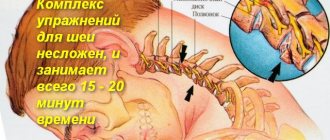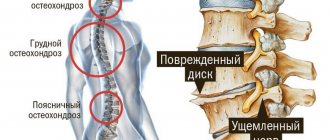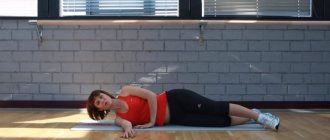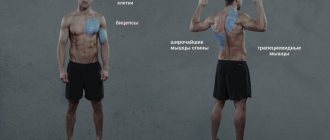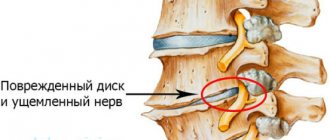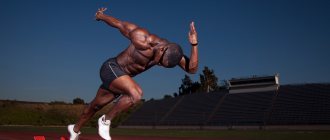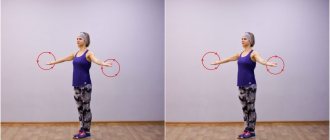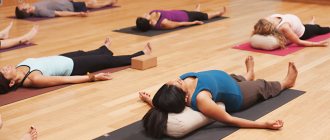Spinal disease has become a scourge in our century; in terms of its scale, it leads among other diseases. If earlier it was said that a disease such as osteochondrosis is an ailment exclusively of older people, now we see a completely different trend. Young people are increasingly becoming victims of osteochondrosis.
The reason for this is progress, the dynamics of our time, banal laziness to do simple exercises - which people simply need.
In workers who sit for hours in front of monitors in offices, the cervical spine is most often affected. Nowadays, people do little physical work; when playing sports, few people pay attention to how correctly the load on the spine and its parts in particular is carried out - with all this we provoke the appearance of osteochondrosis from a young age.
The most common spinal disease today is cervical osteochondrosis. In the fight against this insidious disease, a set of physical exercises for the disease, cervical osteochondrosis, from Dr. Butrimov, is gaining increasing popularity these days.
Why do you need gymnastics for the cervical spine?
Disorders in the cervical spine have a detrimental effect on a person’s overall well-being. After all, the main vessels supplying the brain pass through here. Here, large nerve trunks that participate in the innervation of the head, neck, and upper extremities depart from the spinal cord. Various disorders in this part of the spine manifest themselves in intense headaches (hernia, protrusion, spondyloarthrosis, spondylosis, osteophytes, with chondrosis), increased intracranial pressure, numbness and paresthesia of the hands. The quality of a person’s life deteriorates and sleep is disturbed. Therefore, it is so important to take care of your health in time and perform special gymnastic exercises for the cervical spine.
Exercises and physical therapy (physical therapy) for the cervical spine will serve you well in the prevention and rehabilitation of all kinds of complications.
What to do if everything is very bad
Under no circumstances should you throw yourself into the pool headlong, trying with all your might to complete all the exercises in full through the pain. Rushing will not help here; the difficulty increases gradually. Pull yourself together and don’t be lazy, take into account the recommendations and get started.
Gymnastics, especially therapeutic exercises, are daily work, start with the smallest amplitude, gradually you will develop your neck and remove blocks.
To avoid unwanted results, do not try to immediately turn the cervical spine 180, as Dr. Butrimov shows in his video complexes. What he demonstrates, you still have to achieve through systematic training, and not in one month.
Never sit in one static position for a long time; rest and exercise your neck while sitting in a chair at a computer or working in an office.
Watch your diet, it must be correct. Your depleted cervical discs need amino acids, vitamins, proteins and minerals.
Exercises: basic rules during execution
Exercises for the cervical spine should be performed carefully, without causing further harm to yourself or causing discomfort to the neck. You can perform exercises with a gymnastics stick. Our goal is to achieve deep muscle relaxation. Breathing should be smooth, without forced inhalations and exhalations. You should always remember that the neck is very mobile and any fanatical movement can provoke pinching of a nerve root or vertebral artery. And we already know what this means for the body! Preventive exercises for the neck are the key to your well-being and longevity!
Exercises: there are 5 “golden” rules for correctly performing exercises for the cervical spine. Use them in your daily activities.
- The room for performing a set of exercises should be well ventilated, clothes should be selected with comfort in mind - nothing should constrain you.
- If possible, perform exercise therapy in the fresh air. The body will thank you for this.
- Exercises should not be performed on a full stomach, at least 45 minutes after the last meal.
- Perform all movements without fanaticism, without sudden movements and unphysiological swings. There should be a feeling of slight soreness.
- If the exercises cannot be completed due to deterioration in health, skip them. This means that the body is not yet ready for such a load and exercises should be postponed until better times.
Warnings and Recommendations
Like absolutely every technique, Dr. Butrimov’s gymnastics also has points that must be taken seriously and not ignored. The doctor draws attention to the fact that before starting the exercises:
- The person must feel confident and be able to perform the suggested movements. If something doesn’t work out or you don’t feel confident in yourself and your abilities, you should abandon the exercise.
- You should not be scared by the strange “crunching” sound; this is a completely normal phenomenon when old blockages in the spine (neck) are removed.
- At first, when performing the complex, slight dizziness may appear, you should not worry, the body will get used to it, the brain will begin to be better saturated with oxygen and this condition will not bother you anymore.
- Always keep an eye on your shoulders when performing exercises - this is a very important point, your shoulders should always remain motionless, focus on this while performing the complex, and turn them off from the movement in time. Only the neck - chin - crown work.
Indications and contraindications for performing the exercise
There are special complexes of therapeutic and preventive exercises that prevent the occurrence of cervical osteochondrosis. They are indicated for people whose age exceeds 40, since by this time the cartilage becomes thinner and the former bone tissue loses its organic component. In essence, degenerative processes in the spine are, by and large, a sign of aging of the body.
If osteochondrosis has already developed, then a slightly different type of exercise is required. Healthy neck exercises are suitable here. Osteochondrosis can manifest itself in different ways:
- pain along the spine, cervical-collar region;
- crunching and pain when turning or tilting the head;
- pain in the neck radiates to the interscapular region and arm;
- crawling, numbness of the upper extremities even at night;
- intense headaches spreading from the back of the head to the temples;
- general malaise, morning stiffness, fatigue throughout the day.
There are situations when exercises and gymnastics for the cervical spine are not recommended or are completely contraindicated. Here is a sample list of them:
- exercises and gymnastics are not indicated for instability of the spinal column and its cervical region in particular (hypermobility of the vertebrae, early postoperative period);
- stage of exacerbation of osteochondrosis, when all of the above symptoms are present;
- any infectious-inflammatory diseases at their height (with fever): intestinal infections, inflammation of the thoracic and abdominal organs - with them, exercise is simply physically impossible;
- diseases of the nervous system in the acute stage;
- thromboembolism;
- malignant neoplasms of the spine, neck, thyroid gland;
- myocardial infarction;
- cerebrovascular accident;
- exacerbation of chronic diseases of the skin and its appendages;
- diabetes mellitus in the stage of decompensation;
- tachycardia and cardiac arrhythmia;
- severe myopia.
Consequences of ignoring classes
If you suffer from pain in the cervical spine, then ignoring this terrible symptom will certainly affect your health in the future. Do not forget about the consequences and threats that unrecognized and untreated osteochondrosis carries. In addition, there are aggravating factors, the presence of which, coupled with osteochondrosis, play exclusively against your health:
- overweight;
- metabolic disorders (salt deposition);
- sedentary lifestyle;
- hereditary predisposition;
- sleeping in an uncomfortable position, on an incorrectly selected mattress and pillow;
- bad habits: alcohol, smoking, overeating.
Of course, it is simply not possible to perform exercises on the cervical spine with such a list of aggravating factors.
To achieve the desired result, it is necessary to eliminate these factors, or try to neutralize their effect on neck problems.
Osteochondrosis is insidious with its complications and consequences:
- dysfunction of the spine;
- persistent cerebral circulatory disorder;
- constant paresthesia, numbness of the hands (impaired performance);
- pinched roots in the cervical spinal cord can lead to disability.
Often advanced problems in the cervical spine are accompanied by disorders in neighboring organs.
Expander
There are many exercises for developing the muscles of the arms, forearms, muscles in the thoracic and cervical region, which are performed with a simple and affordable expander exercise machine. An elastic flat or tubular tourniquet with two comfortable handles can be attached to the wall, at the level of the thoracic region, and standing with your back to it, perform alternating arm raises with tension on the expander. You can also stand in the middle of the tourniquet with your feet and perform arm raises with the ends of the machine clamped. There are exercises that strengthen the lower body, as well as stretching exercises.
Training methods
The set of exercises for the cervical spine varies depending on the functional state of the latter. There are specially designed exercises that are aimed largely at preventing neck problems. In addition, there are gymnastic exercises for existing problems, for example, with osteochondrosis, as well as a unique method of working on the Drevmass simulator. Let's look at each method separately.
Each technique requires careful selection with an emphasis on the functional state of the body and the subjective well-being of a person. A physiotherapist will help you with this. Physical therapy exercises can be performed both at home and in a specialized hospital.
How to treat thoracic osteochondrosis
To treat osteochondrosis of the cervicothoracic region, a variety of rubbings, compresses, medicinal patches and other medications for osteochondrosis are used.
Compresses, rubbing and healing patches are designed to warm the sore spot. Irritation and warming of tissues during the treatment of osteochondrosis in the cervicothoracic region promotes blood flow to the problem area. Increased blood circulation helps to quickly relieve inflammation, removes toxins and, ultimately, normalizes the condition of the spine.
Home treatment for thoracic osteochondrosis includes performing simple exercises that will relieve pain and restore flexibility to the spine:
• Bend your torso forward, making sure your back is straight. • Bend back, shoulders should be straightened, back straight. • Turn the body first to the right and then to the left. This exercise is best performed while standing near a wall, trying to reach it with your hands while turning your body.
Preventive exercises
With the help of therapeutic and preventive exercises for cervical osteochondrosis, you can comprehensively and qualitatively improve your well-being and improve the condition of the body. Mostly isometric exercises are described here. However, there is an indispensable condition: the patient must be ready to perform moderate physical activity. And here, first of all, we mean the absence of diseases from the list of contraindications. So let's get started.
Perform each exercise 5–10 times:
- While standing or sitting, alternately bend your head forward and backward. When bending forward, your chin should touch the chest cavity. When tilting your head back, try not to overextend your neck.
- From the same position, we smoothly lower our head first to one shoulder, then to the other. We try to reach the shoulder girdle with our ear.
- We turn our heads to the sides (look to the sides) until the most comfortable stop.
- From the starting position, we bend our head forward, as if diving under water (see photo).
- From their starting position, we place the palm of our left hand on our forehead and, with emphasis, bend our head forward, while trying to overcome the resistance. We repeat the same thing, placing the palm of our hand on the back of our head and bowing our head back.
- Following the example of the previous exercise, we make similar movements with the only difference being that the head movement should be to the sides.
- Exercise to stretch and relax the neck muscles. Stand up straight, arms along your body. Stretch your neck forward and turn your head left and right, trying to reach your chin to your shoulder.
- Stretching the head and neck to the side according to the previously worked pattern.
- Pulling the head into the shoulders, as if we are showing “I don’t know.”
We bring to your attention a video with preventive exercises for the neck:
This kind of gymnastics is indicated for people with sedentary work, prone to stress and psycho-emotional overload. It will not harm those who abuse poor nutrition, which affects the deposition of salts in the joints.
Gymnastics
Alternative Eastern medicine has a large arsenal of gymnastic techniques for neck pain. We bring to your attention qigong gymnastics. Qigong gymnastics is a traditional Chinese system of breathing and physical exercises.
- In a standing or sitting position, the body is relaxed, warm up your hands by rubbing them together. Next, alternately rub the back of your neck with both palms using moderate force. Perform the movement 8 times. After this, alternately rub the side surfaces of the neck - 8 times. Then, with the outer palm of your hand, make 8 similar movements from the lower jaw to the place above the jugular fossa.
- While in the same position, bring your hands back, clasping them together. As you inhale, stand on your toes, raise your head, and press your hands on the lower part of your neck in an upward and forward direction, gradually increasing the force moderately. Perform 8–10 times.
- Standing straight, chin down on your chest, smoothly make circular movements with your head to the right, then to the left. During the exercise, you can mentally imagine circles described by your head during rotation. Repeat 10 times.
- Starting position of exercise No. 3. We turn our head, rolling our chin over our chest, drawing a semicircle from the right to the left all the way, and back. Only the head moves. Repeat 10 times.
This gymnastics for beginners is easy for anyone to do. But we must remember that qigong is also a spiritually oriented practice. It also includes meditative training: visualization and concentration on specific images, sounds, and special breathing techniques.
You can also learn many valuable gymnastic exercises for the neck by watching the following video:
Author's methods
Rehabilitation centers use sets of exercises compiled by highly specialized doctors - orthopedists, traumatologists, chiropractors. The goal of training using the author's methods is not only to strengthen muscles, but also to rehabilitate with partial restoration of cartilage and bone vertebral structures damaged by cervical osteochondrosis.
Physiotherapy exercises by Dr. Ignatiev
The doctor has developed therapeutically effective exercises to quickly improve the patient’s well-being. Their implementation allows you to eliminate pain and stiffness in the shortest possible time. To do this, during training, movements must be combined with calm, deep breathing.
Exercises according to the Bubnovsky system
Dr. Bubnovsky has developed a method of kinesitherapy - the treatment of chronic pathologies of the spine with movement, including resistance. The most effective training is carried out in rehabilitation centers equipped with special simulators. S. Bubnovsky claims that as long as a person can move, he is able to heal.
Another article on the topic: Exercises for cervical osteochondrosis according to the Gitt method of Vitaly Demyanovich.
Gymnastics according to Shishonin's program
This is a unique proprietary method of therapeutic training, developed for patients with frequent neck pain. Performing exercises is recommended for low physical activity and non-compliance with the daily routine as a preventive measure for cervical osteochondrosis. The complex includes only seven exercises, which should be performed 3-4 times a week.
